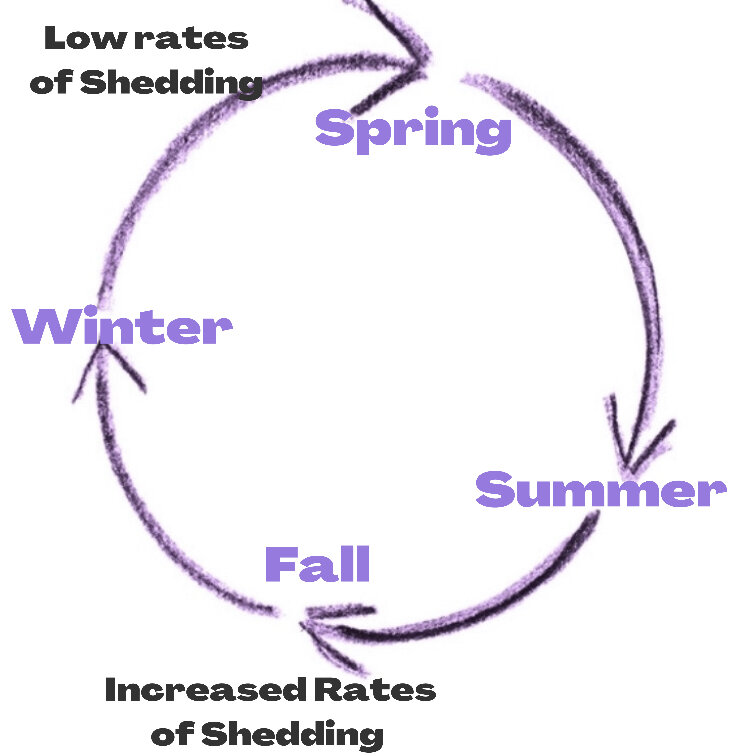Seasonal Shedding: Is my pattern normal ?
Is it normal to shed more in the summer months?
I’ve selected this question below for this week’s question of the week. It allows us to discuss the topic of seasonal shedding. Here is the question….
QUESTION
I am a 35 year old female. For the last several years I have noticed the following shedding pattern. In the late fall and winter, I lose around 40 hairs a day. In the late spring the number begins to rise and I shed around 65 hairs during the summer months and into the early fall. Shedding then drops back to around 40 hairs a day and the cycle repeats itself. The result is, I am terrified and stressed every summer thinking “my hair is falling out”.
My question is … is this normal or do I have a problem?
My part is tight year round and my shedding is diffuse throughout my scalp. If this is normal, then I can relax and enjoy my summers.
ANSWER
You certainly give a story that is highly suggestive of what is known as “seasonal shedding.” Whether or not there could be another explanation would require a review of the scalp during one of the shedding episodes but anything else would be extremely rare.
Seasonal shedding is a type of telogen effluvium (hair shedding disorder) and is much more common than we realize. Humans appear to shed less in the winter and more in the summer. Based on all the studies done to date, there actually appears to be two peaks of shedding - a main one in the late Summer/early Fall and a minor one in Spring. Your story certainly sounds like you fit this picture.
Do you need to worry ? The answer to that question is easy to figure out although I’d need you to do a bit more searching on your own. If your hair density on New Years day this past year was the same as the density on New Years day the year before, you don’t need to worry - this is likely only seasonal shedding that’s happening each spring-summer-fall. If you are experiencing seasonal shedding but find that your density is in fact getting a bit less as the years go by - then you should have a proper examination to rule out a second condition that might be present (like androgenetic alopecia). You mention your part remains tight - so it seems your story is more likely that of classic seasonal shedding.
It really is that straight forward. If you feel that your photos from every winter are identical year after year after year and your hair feels the same in winter months year after year after year …. then you can relax and enjoy your summers. That would indicate a classical seasonal shedding.
Seasonal shedding is more common than most people realize. For reasons that are not entirely clear, humans shed more hair from the scalp in late summer and early Fall.
Past Studies of Seasonal Shedding
There have been five good studies from 1991 to 2014 that all point to the same general message: humans shed more in the summer and early Fall. Some studies like those of Courtois and colleagues in 1996 and Kunz and colleagues in 2008 suggested that some humans also might shed a bit more in early Spring (a second peak). The main shed, however, is in summer/Fall.
If you’re interested in reading more about these 5 studies, I’d invite you to check out a previous article I wrote:
Seasonal Shedding of Hair: Five Studies to Know About
CONCLUSIONS:
Thanks again for the question. Good luck as you think back to your hair over the winter months in past years. This is where the answer lies for you.
As for the” why” - why does shedding occur more in summer? Well, we don’t really know although it is proposed that climate factors and UV radiation related factors may somehow be involved.
It’s pretty common for people to worry about hair shedding in summer. A 2017 study in the British Journal of Dermatology showed that people are punching the words “hair loss” into the Google search engine far more in the summer and Fall than they are in the sping and winter. Large numbers of people share the same concerns as you’ve raised.
References
Courtois et al.Periodicity in the growth and shedding of hair. Br J Dermatol, 1996 Jan;134(1):47-54.
Hsiang EY et al. Seasonality of hair loss: a time series analysis of Google Trends data 2004-2016. Br J Dermatol2018; 178(4):978-79
Liu et al. A Microarray-Based Analysis Reveals that a Short Photoperiod Promotes Hair Growth in the Arbas Cashmere Goat, PLoS One. 2016 Jan 27;11(1):e0147124.
Maurel D et al. Effects of photoperiod, melatonin implants and castration on molting and on plasma thyroxine, testosterone and prolactin levels in the European badger (Meles meles). Comp Biochem Phyiol A Comp Physiol. 1989;93(4):791-7.
Orentreich N. Scalp hair replacement in man. In: Advances in Biology of Skin. Vol IX: Hair Growth. (Montagna W, Dobson RI, eds). Oxford: Pergamon. 1969. 99-108.
Pearson AJ et al. Inhibitory effect of increased photoperiod on wool follicle growth. J Endocrinol 1996 Jan;148(1):157-66.
Piérard-Franchimont C, Peérard GE .L'effluvium télogène actinique: une facette de la chronobiologie humaine.
Int J Cosmet Sci. 1999 Feb;21(1):15-21.
Randall and Ebling. Seasonal changes in human hair growth. Br J Dermatol 1991.
Reinberg A et al. Circadian and circannual rhythms in plasma hormones and other variables in five healthy young males. Acta Endocrinology 1978; 88: 417-27
Smals AGH et al. Circannual cycle in plasma testosterone levesl in man. J Clin Endocrin Metab 1976; 42: 979-82.
Zhang et al. Comparative study on seasonal hair follicle cycling by analysis of the transcriptomes from cashmere and milk goats. Genomics 2019 Feb 16



